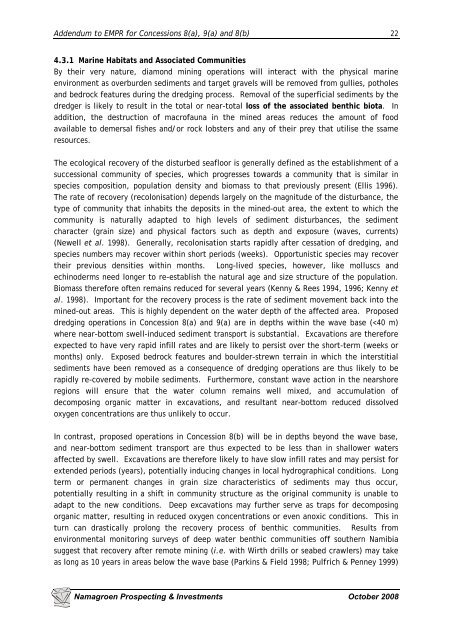NAMAGROEN EMPR Amendment.pdf - DLIST Benguela
NAMAGROEN EMPR Amendment.pdf - DLIST Benguela
NAMAGROEN EMPR Amendment.pdf - DLIST Benguela
You also want an ePaper? Increase the reach of your titles
YUMPU automatically turns print PDFs into web optimized ePapers that Google loves.
Addendum to <strong>EMPR</strong> for Concessions 8(a), 9(a) and 8(b) 224.3.1 Marine Habitats and Associated CommunitiesBy their very nature, diamond mining operations will interact with the physical marineenvironment as overburden sediments and target gravels will be removed from gullies, potholesand bedrock features during the dredging process. Removal of the superficial sediments by thedredger is likely to result in the total or near-total loss of the associated benthic biota. Inaddition, the destruction of macrofauna in the mined areas reduces the amount of foodavailable to demersal fishes and/or rock lobsters and any of their prey that utilise the ssameresources.The ecological recovery of the disturbed seafloor is generally defined as the establishment of asuccessional community of species, which progresses towards a community that is similar inspecies composition, population density and biomass to that previously present (Ellis 1996).The rate of recovery (recolonisation) depends largely on the magnitude of the disturbance, thetype of community that inhabits the deposits in the mined-out area, the extent to which thecommunity is naturally adapted to high levels of sediment disturbances, the sedimentcharacter (grain size) and physical factors such as depth and exposure (waves, currents)(Newell et al. 1998). Generally, recolonisation starts rapidly after cessation of dredging, andspecies numbers may recover within short periods (weeks). Opportunistic species may recovertheir previous densities within months. Long-lived species, however, like molluscs andechinoderms need longer to re-establish the natural age and size structure of the population.Biomass therefore often remains reduced for several years (Kenny & Rees 1994, 1996; Kenny etal. 1998). Important for the recovery process is the rate of sediment movement back into themined-out areas. This is highly dependent on the water depth of the affected area. Proposeddredging operations in Concession 8(a) and 9(a) are in depths within the wave base (












